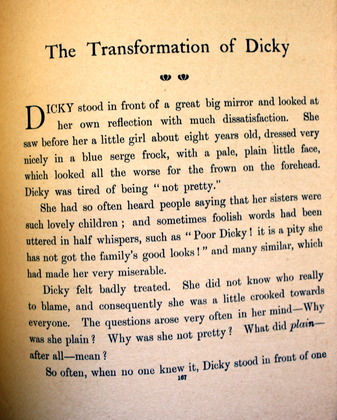Christianity and Moral Didacticism
‘The Transformation of Dicky’ is a morally didactic fairy tale, incorporating religious motifs, which cautions the reader against the sin of vanity. The heroine of the tale despairs of her plainness, considering herself ‘”not pretty”’ (p.167), and vents her frustration on those around her: ‘sometimes […] she stamped her foot and felt impatient and at war with all the world’ (p.168). There was a firm emphasis in Victorian children’s literature on the importance of cheerfulness and learning to control one’s temper, and in Fenwicke-Allan’s work this is generally portrayed as a Christian responsibility. The religious and magical intervention in this story comes in the form of Richard Couer de Lion, the ‘most beautiful peacock’ (p.170) belonging to the household. The character’s namesake, Richard I, was a pious Christian monarch who led England’s third Crusade to the Holy Land in 1190, and this religious symbolism is stressed by the peacock entering the narrative immediately after Dicky commits the sin of impugning the divine: ‘O God, why did you make me so ugly?’ (p.170). The peacock acts as the moral counterpoint, identifying her suffering as ‘ungratified vanity’ and assuring her that ‘beauty is a vain and useless thing’ (p.171).
</>And therein lies the moral of the tale; Dicky ultimately learns her lesson by nonetheless electing to change places with the peacock, choosing an existence of idle vanity over a life of humility. While Richard Couer de Lion thrives as a little girl, ‘winning all hearts’ (p.177) by exhibiting fair temperament despite Dicky’s plain outward appearance, the protagonist realises she has ‘an empty life’ (p.178) of beauty without purpose, and that she ‘could have been happy as an ugly child, if I had chosen to use the gifts God had given me. God is good, and He is far wiser than I’ (p.178). By repenting Dicky is redeemed, and when she is critically wounded by a dog Richard Couer de Lion offers to exchange places once more, sacrificing himself so that she may live. Converted into a ‘clever and charming girl’ (p.181) by her exercise in humility, the character is transformed into ‘an angel’ (p.181) in the eyes of her elders, by implication the acme towards the Victorian child should strive.









